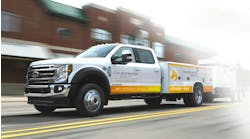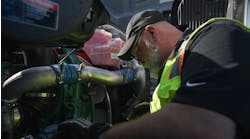Service providers tend to have a firm grasp on how to fix vehicles and equipment. However, they have an imperfect understanding of the entire process of fixing these assets and how to deliver what their customers want.
The reason for this: large inefficiencies in how fleets and service providers work together to get vehicles up and running again, and disparate priorities.
That is the contention of Mike Delaney, president and CEO of WheelTime, made in his keynote address to this year's TMCSuperTech2012 (the Technology & Maintenance Council's National Technician Skills Competition) Luncheon, held in early September in Pittsburgh, PA.
WheelTime is a professional truck care and service network that offers support through its WheelTime Quality Truck Care Network with more than 30 training facilities and more than 200 service centers located across the U.S., Canada and Australia.
Overriding Concern
When vehicles encounter unscheduled maintenance or repair, fleets want them back on the road quickly. With repair quality as a given, speed becomes the overriding concern, Delaney said. But some vehicles spend more time in vendor shops than others, even for the exact same repair.
To learn the reasons why, WheelTime conducted a study in which it compiled data on more than 300 repair events spread across 49 separate locations. The analysis also looked at categories of repairs and the various sub-processes that impacted total time-out-of-service - things like the time to diagnose, get approvals, acquire parts and actually do the repair.
"What was immediately clear was that actually fixing the asset wasn't the problem, and shop time wasn't very different between customers," he reported. "What created differences in time out-of-service for similar repairs - sometimes big differences - was whether the focus was on managing the asset or on managing the event."
Most service suppliers manage assets, said Delaney. Assets get dropped off, assessed, fixed and get returned to customers. While attempts are made to accommodate urgent requests, the real priorities come down to efficiently running shops. A shop's business systems focus on running the business of fixing assets.
A Disconnect
The fleet managers' perspective is different, Delaney observed. When a revenue-producing asset breaks, to the fleet manager it is a costly, disruptive event that needs to be handled quickly.
"His focus isn't on the fixing," he pointed out, "It's on managing the event itself, and this is where service providers and fleets are completely disconnected.
"Fleets and service suppliers generally want a positive outcome for each other. The problem is that each is managing to a different set of variables and priorities.
"Also, each has a different set of information to work with. Getting on the same page with that information is the core of the problem."
In measuring the total time from arrival to pick-up of the asset at a shop, the WheelTime survey revealed that "the bulk of the total time elapsed had nothing whatsoever to do with fixing the asset," said Delaney. "It had to do with compiling information - figuring out not only what is going on with the vehicle, but exactly how the customer wants it handled."
The time it takes for this "can be significant and it adds inefficiency to the process."
Collaboration is Key
To get more work from customers, service providers have to fix the whole process of fixing things, urged Delaney. There has to be meaningful collaboration so that information and key decisions can move more quickly and get handled in a predictable way. "The more seamlessly fleets and service providers can work together, the better, faster and cheaper the repair process becomes for everyone."
When a fleet works on its own vehicles, collaboration is easier, as key information, such as a unit's spec and history, are readily available, shop processes are known, approvals may be automatic and there is more control in general, he explained. Collaboration between internal people and systems makes gathering key information for decision-making easier.
"Likewise, things can move faster when fleets work with service providers they already know and trust. The more companies work together, the more people already know what needs to be done. No decisions are faster than the ones made in advance, and with rules, limits and preferences in place, things can hustle right along."
But large fleets can have thousands of potential service providers in their databases, Delaney said. Many are not known or trusted, aren't connected to any of a fleet's systems and have different ways to doing things, all of which creates complexity, confusion and cost.
"Much of the time it takes to get equipment through outside shops can be spent just getting on the same page and ready to do work. Strangers collaborate as best they can by phone asking questions or by leaving messages to ask questions."
New Tools and Technologies
The service providers that will be successful as time goes on will be those that adapt new tools and technologies to serve their customers the way customers want it done, asserted Delaney. That involves getting "wired" electronically with fleets for improvements in speeding the repair process. This results in reduced costs for both parties, plus the elimination of costly misunderstandings.
"We use the latest technology in our personal lives. Why do we settle for old methods and tools in our work?
"Technology allows us to be better, faster and more efficient at the same time," he continued. "But it allows us to do something else that may offer the most important advantage of all. It allows us to be consistent.
"People are unique. Technology driven processes aren't. Only processes, not people, can create consistency.
"If franchises like McDonald's can create a culture of consistency around a $4 happy meal, surely we can drive more consistency into working on $150,000 trucks?
"New technology," he concluded, "allows us to do a lot more with the same resources."




